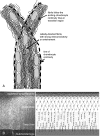Micro-anatomical response of cartilage-on-bone to compression: mechanisms of deformation within and beyond the directly loaded matrix
- PMID: 17062019
- PMCID: PMC2100340
- DOI: 10.1111/j.1469-7580.2006.00646.x
Micro-anatomical response of cartilage-on-bone to compression: mechanisms of deformation within and beyond the directly loaded matrix
Abstract
The biomechanical function of articular cartilage relies crucially on its integration with both the subchondral bone and the wider continuum of cartilage beyond the directly loaded contact region. This study was aimed at visualizing, at the microanatomical level, the deformation response of cartilage including that of the non-directly loaded continuum. Cartilage-on-bone samples from bovine patellae were loaded in static compression until a near-equilibrium deformation was achieved, and then chemically fixed in this deformed state. Full-depth cartilage-bone sections, incorporating the indentation profile and beyond, were studied in their fully hydrated state using differential interference contrast microscopy. Morphometric measurements of the indented profile were used in combination with a force analysis of the tangential layer to investigate the extent to which the applied force is attenuated in moving away from the directly loaded region. This study provides microscopic evidence of a structure-related response in the transitional zone of the cartilage matrix. It is manifested as an intense chevron-type shear discontinuity arising from the constraints provided by both the strain-limiting articular surface and the osteochondral attachment. The discontinuity persists well into the non-directly loaded continuum of cartilage and is proposed as a force attenuation mechanism. The structural and biomechanical analyses presented in this study emphasize the important role of the complex microanatomy of cartilage, highlighting the interconnectivity and optimal recruitment of the load-bearing elements throughout the zonally differentiated cartilage depth.
Figures








References
-
- Akizuki S, Mow VC, Muller F, Pita JC, Howell DS, Manicourt DH. Tensile properties of human knee joint cartilage. I. Influence of ionic conditions, weight bearing, and fibrillation on the tensile modulus. J Orthop Res. 1986;4:379–392. - PubMed
-
- Benninghoff A. Form und bau der Gelenknorpel in ihren Bezeihungen zur Funktion. Z Zellforsch Mikrosk Anat. 1925;2:783–825.
-
- Broom ND. Abnormal softening in articular cartilage: its relationship to the collagen framework. Arthritis Rheum. 1982;25:1209–1216. - PubMed
-
- Broom ND, Marra DL. New structural concepts of articular cartilage demonstrated with a physical model. Connect Tissue Res. 1985;14:1–8. - PubMed
Publication types
MeSH terms
LinkOut - more resources
Full Text Sources

